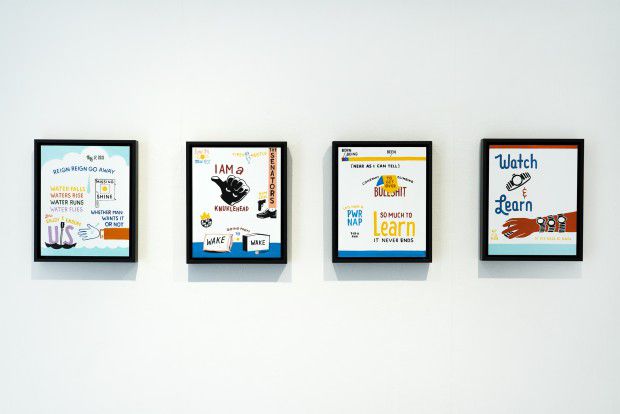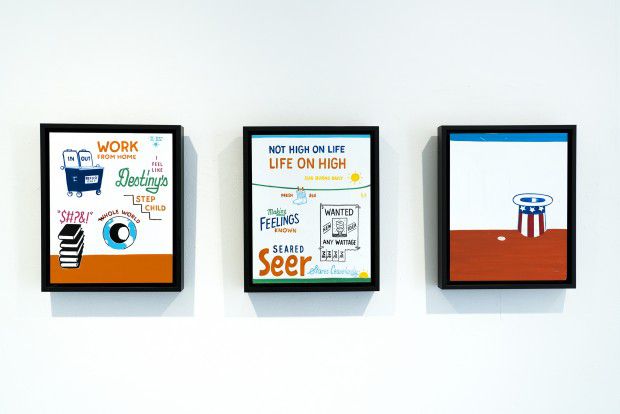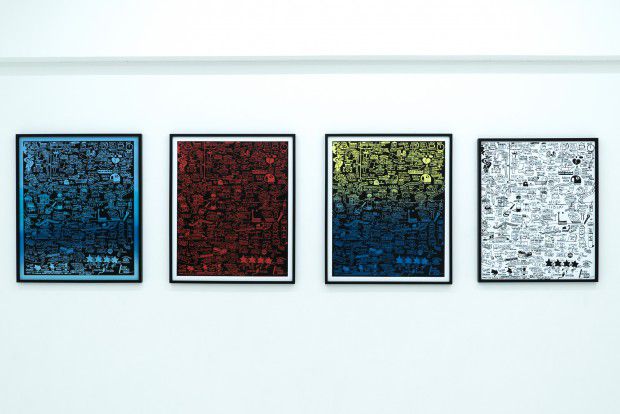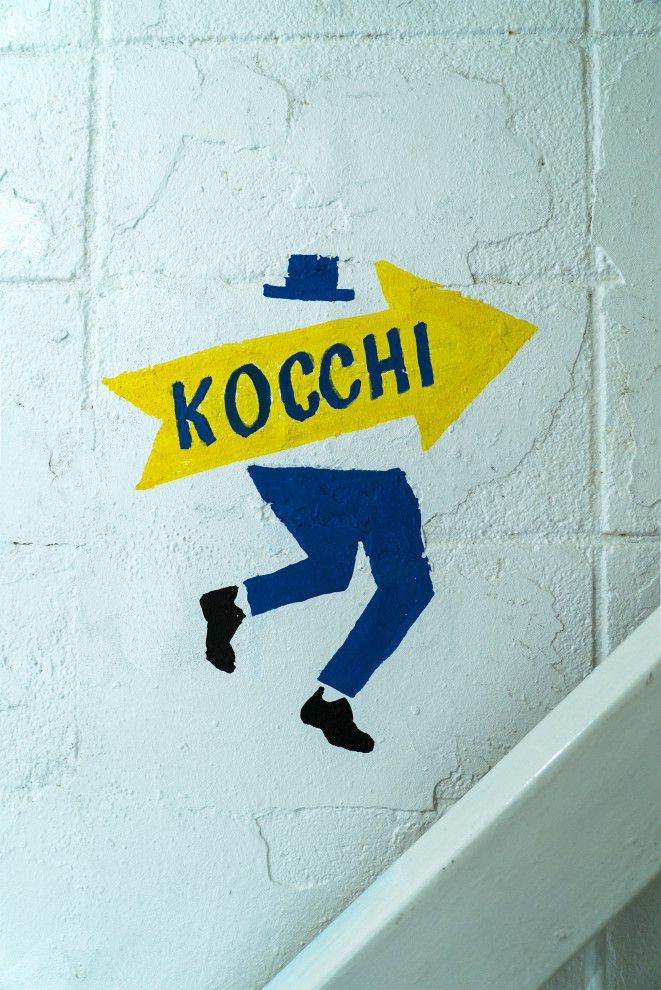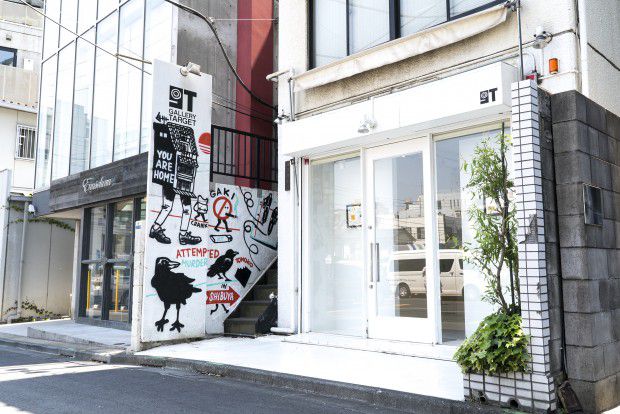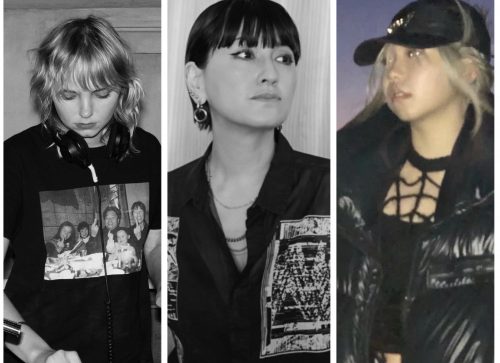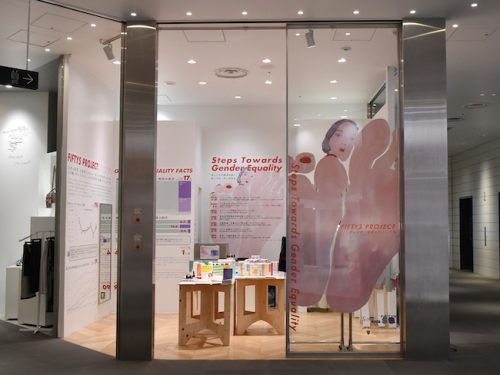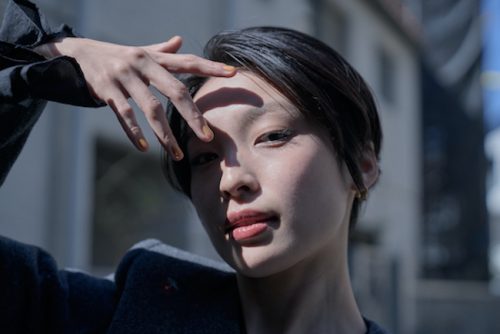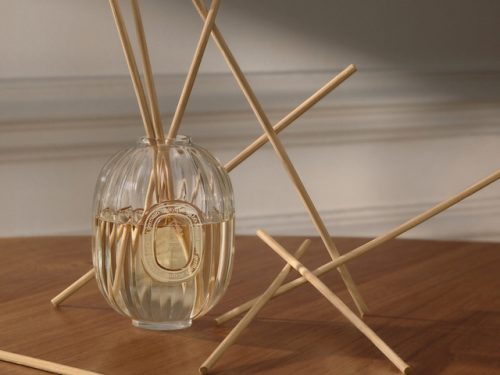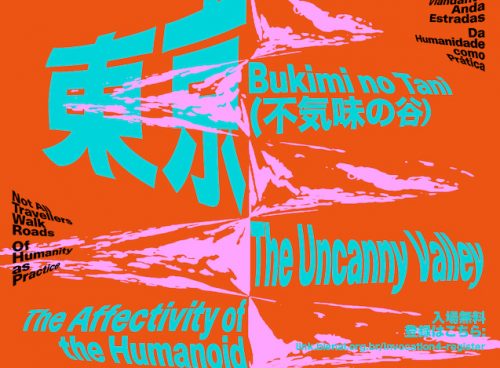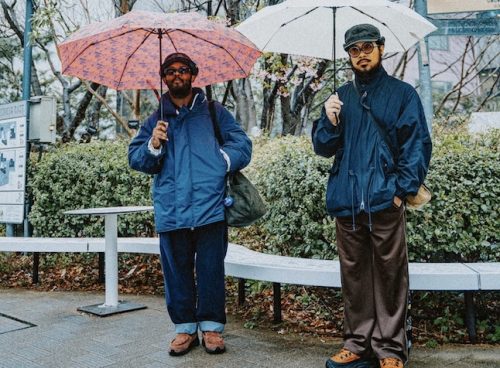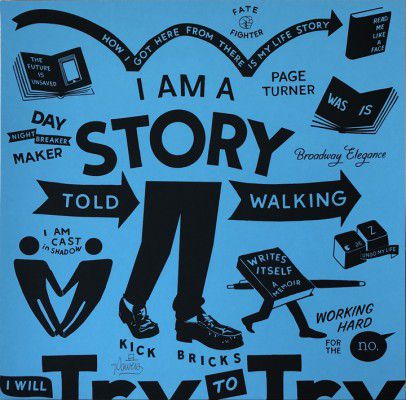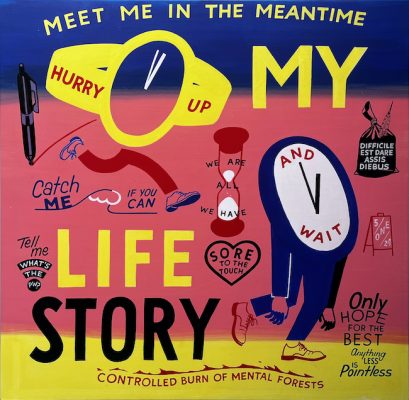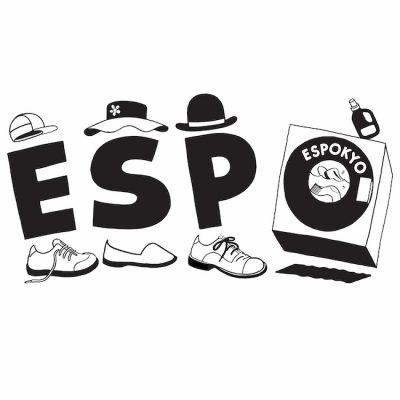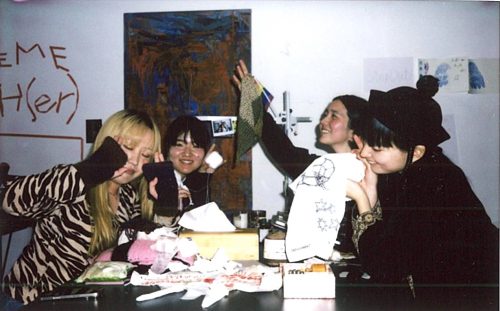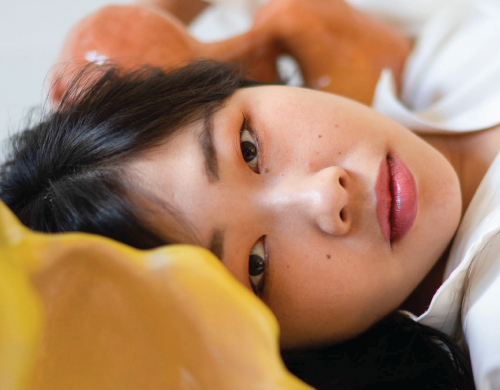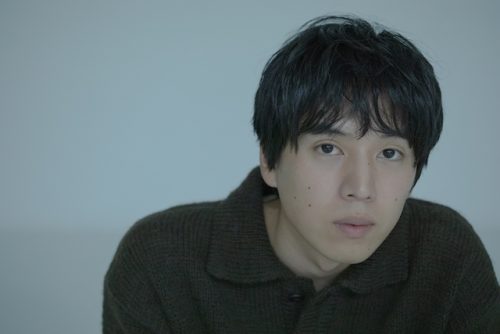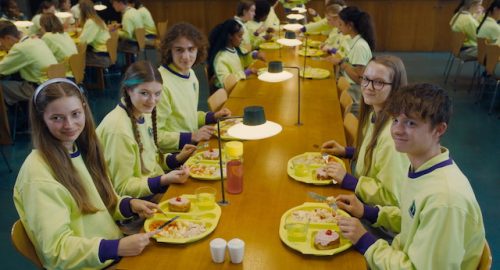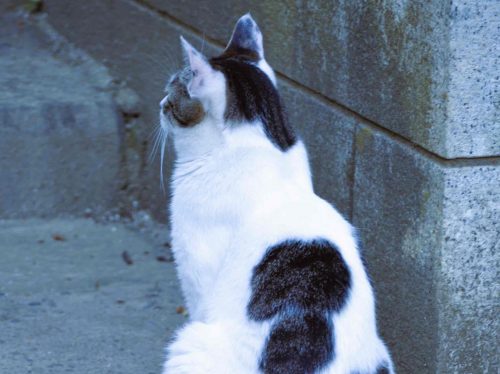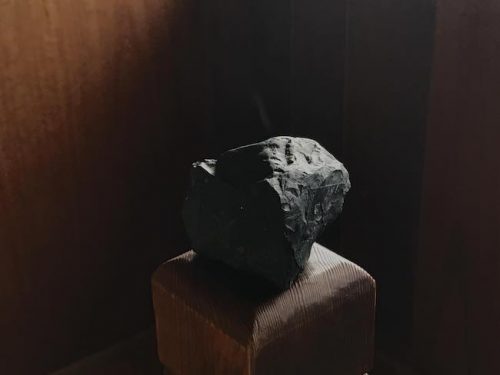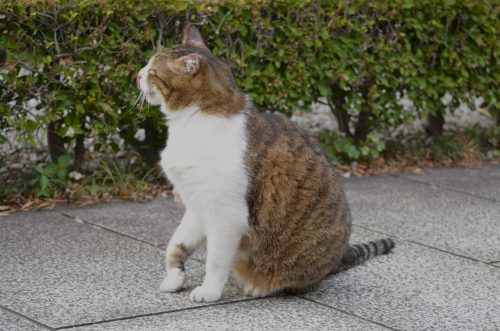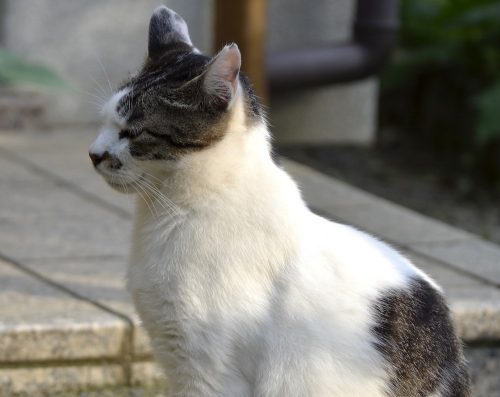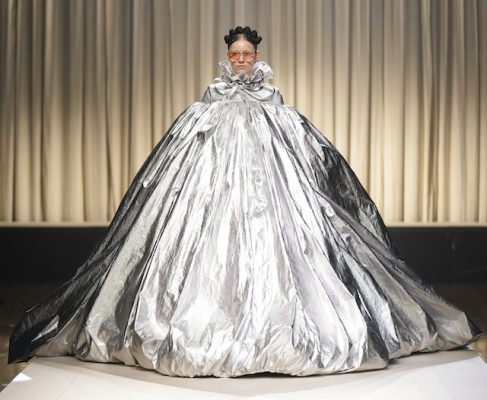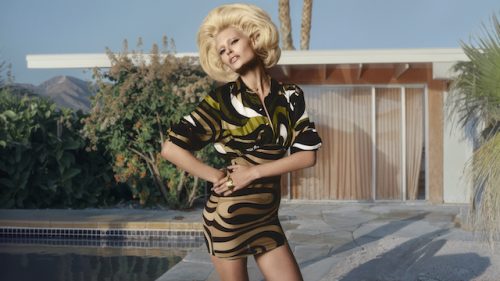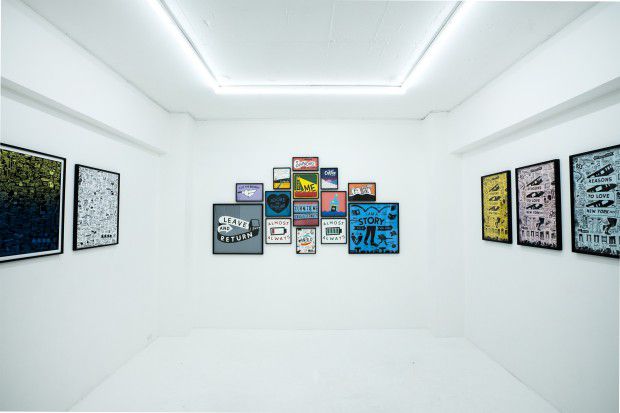
16歳の頃からグラフィティ・ライターESPOとして広く名を知られる存在であり、1999年からはライターを辞めてアーティスト活動を行なっているスティーブン・パワーズ。ベネチア・ヴィエンナーレやリバープール・ヴィエンナーレに参加し、世界中の美術館やギャラリーにて精力的に作品を発表し続ける彼の4年ぶりの個展が開催された。シンプルでいながらポジティヴなパワーとエレガントさを備えた作品について聞いた。
— 今回、個展のタイトルに「There Are No Wrong Answers」とつけた理由は?
Stephen “ESPO” Powers 「GALLERY TARGETと一緒に考えたんだけど、彼らも僕も夢を見ていたし、夢を見ながら生きているとすべてが可能になってくる。誰かを傷つけていない限り、その答えに間違いはないしね。そういう意味だよ。創造性があって自由であるということでは、GALLERY TARGETでスタートできたのは良いことだと思う。僕たちはすべてが可能であるからこそ始めたし、うまくことが運ばないことは排除したんだ。一番シンプルな答えは自由であることだったんだ。自由を大切にする良い時期だと思ったんだ」
— The title of your solo show is “There Are No WrongAnswers”. What did you put into this title, and what is the difference from 4 years ago?
Stephen: “It was really working because of working with GALLERY TARGET. It always seems like we always have a lot of possibilities. They dream and we’re both dreamers. When you dream for a living, when it’s really your profession and you’re dreaming all the time, everything is possible and everything is a different possibility. There really are no wrong answers, as long as you’re not hurting anybody, there are no wrong answers. So, I think just in terms of being creative, and being free, that’s a good place to start. We start with everything being possible and eliminate what’s not working. I think about freedom, simply. Simplest answer is it’s about freedom. It’s a good time to cherish freedom.”
— 自由であることは、16歳の頃に活動を始めた頃から考えていることですか?
Stephen “ESPO” Powers「16歳の頃に絵を描き始めるようになったのかな。学校へ行っていた頃に絵を描くことを教える、ということを理解したというか、そこですべてのルールを学んだんだ。子供の頃は才能があったし、タレント性もあったから、学校ではいつもアートを学ぶプログラムへ行くことを勧められていたんだ。僕は指図されるのが嫌でたまらない子供の1人だったから、先生が何か僕に言うと、すぐに逆のことをしていた。振り返ってみると、すごく嫌な気分になるね……というのも彼ら(先生)は、僕がいい感じにやっていたことを知っていたと思うし、それと今、自分の息子を見ても彼は自分のやりたいようにやっていくだろうからとやかく外野が言うことじゃないんだ。グラフィティはまさに自分がやりたいことだった。自由で、誰の期待に沿わなくていいというね」
–Were you always thinking about freedom when you started art? You started at 16 years old, right?
Stephen: “I started drawing, I suppose, when I was sixteen. A big part of it was I was in school and I understand that there is way of teaching art, and you learn all the rules. When I was small, it was always I was gifted, I had talent, so they always taught me and pushed me towards going into programs where I would learn art from teachers. I was one of those kids that never wanted to get any instructions. If teachers told me something I would do the opposite. And looking back, I feel really bad because I know they meant well, and with my own son I can see he wants to do things his own way. Graffiti was a way of doing exactly what I wanted to do, and be free, and not have to live up to anybody’s expectations.”
— 初めてグラフィティを見たときのことを覚えていますか?
Stephen “ESPO” Powers 「僕はずっとグラフィティが好きではなかったんだ。フィラデルフィアに居た頃だけど、最初は全く理解ができなかったんだ。そんなときに友達が『オマエに見せたいものがある。俺の友達が昨晩描いたんだよ』と言ってきたんだ。彼は僕を電車の車両が停まっている場所へ連れて行ってアートピースを見せてくれたんだ。それは今でも僕がすごく仲良くしている友達が描いたものだった。その頃、よくみんなで家に集まってTVでやっている映画を観ていたんだけど、映画の中で男が外に出かけてペイントしているシーンがあったんだ。電車に描かれたものは、思わず『ワオ~!』と声が出てしまうくらいで映画で見たものよりも断然よかった。彼は完全に何かを成し遂げていたんだ。そのピースは本当に素晴らしいものだった。それを見たときに、『これは俺がやるものだ!』『理解できたから、今すぐやらないと!』と思ったんだよ」
–Do you remember your first time seeing graffiti art on walls, and how shocking it was?
Stephen: “It was really funny because for a long time I didn’t like it, I didn’t appreciate it. At first I didn’t understand it, so I didn’t like it. In Philadelphia. And then a friend of mine, showed me something. He said, “I wanna show you something. My friend painted this work last night.” He took me to the train tracks and he showed me a piece of artwork, that now a very good friend of mine painted. We were all home watching a movie on T.V., when this guy went out and he painted something, and it was just so much better than the movie, haha. I was like wow, he’s actually doing something. We forgot about the movie, but this piece is still here, it still looks great. When I saw that, I was like this is for me. I get it now, I understand.”
— ESPOとグラフィティネームをつけた理由は?
Stephen “ESPO” Powers 「僕はKAWSとREAS(Casey REAS)の友達でもあるし、たくさんの素晴らしい現役のグラフィティアーティストや、過去にグラフィティをやっていた友達を知っている。16歳でイリーガルでグラフィティをはじめたとき、僕は『犯罪を犯した』と認識したんだけど、自分のアートにその部分を織り交ぜたいとは思わなかったんだ。僕はあくまでもグラフィティを描きたかっただけだった。だからESPOという名前はグラフィティネームなんだ。グラフィティをはじめて、20年後に辞めて、それ以来アーティストとしてやっているけど、これまでにESPOという名前を自ら宣伝したことはない。グラフィティライターがギャラリーで名前を使うことは、フェアではないと思っているんだ。だけど正直言えば、哲学的に僕はステファン・パワーズでいたかっただけなんだけどね。でも20年経ってもみんな僕のことを『ESPO!』って呼ぶんだよ(笑)。きっと呼ぶのに楽なんだろうね。だからESPOは僕の一部であって、今も僕の中にある名前なんだよ」
–Why did you name yourself ESPO?
Stephen : “I’m friends with Kaws and Reas, and a lot of really good artists that are graffiti writers, or used to be graffiti writers. What I thought about graffiti was, when I was sixteen and I was writing graffiti and I was doing it illegally, and I was “committing crime”, I didn’t want to mix my art into it. I just wanted to paint graffiti, I didn’t want to do art. I wanted to just make graffiti. So, ESPO for me is graffiti. It’s my graffiti name. For 20 years after I stopped writing graffiti, and I was working as an artist, I never promoted myself as ESPO. I didn’t think it was fair to the graffiti writers to promote my graffiti in a gallery. I wasn’t really risking anything. The smart thing would’ve been to keep saying my name, like “I’m ESPO I’m ESPO I’m ESPO”, but philosophically I think I wanted to be honest about it and stand as Stephen Powers. I thought it was fair to leave the graffiti with the graffiti. But after 20 years, people still call me ESPO! They want to call me ESPO, they want to say “Hey ESPO!”. It’s a fun name to say, it’s fun to yell. At this point now, people know even though I didn’t trade on the name, I didn’t promote the name, I did it honestly and the name is still there. The name is still inside of me, it’s a part of me. That’s all it is.”
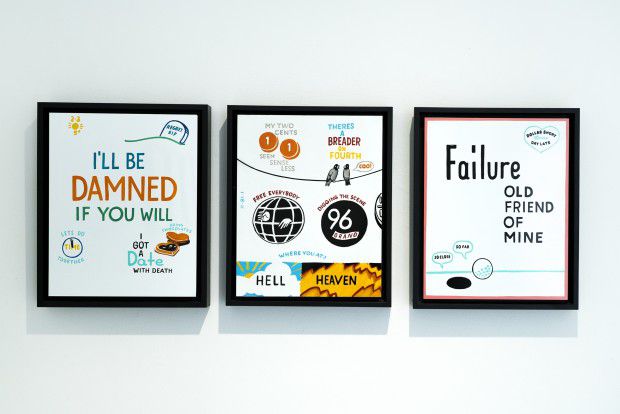
— ESPOとステファン・パワーズの違いをあえて言いますと……。
Stephen “ESPO” Powers 「アプローチが違うだけで、特に大きな違いはない。ESPOは短くて早いバージョンで、ノリにのった感じ。ステファン・パワーズは長い……(遠くにタクシーが走っているところを指差して)あのタクシーみたいな感じ。ESPOが早くて小さなモーターサイクル、デリバリーのスクーターみたいな感じだとしたら、ステファン・パワーズはタクシーみたいにもう少しゆっくりした、上品でいい感じになるんだ。日本のタクシーはドアが自動で開いて、とても綺麗で、道もよく知っているからね。それに比べて小さなスクーターみたいなESPOは、UBER EATSみたいなものなんだよ。道路上ではイリーガルなことをしたりもする。警察はESPOを面白おかしく見ていて、タクシーみたいなステファン・パワーズを尊敬している。タクシーの運転手は運転免許を持っていて、保険にも入っていて、ペーパーワークもパスしている。でもデリバリーガイは法律を破って、ところ構わず駐車してってまるでガキ(悪ガキ)みたいな行動をとる。そんな違いさ」
–What are the differences between “ESPO” and “Stephen Powers”?
Stephen: “Nothing, just approach. ESPO is a shorter, faster version, it’s like a hot ride. Stephen Powers is like a long…it’s like a taxi cab. ESPO is like a little motorcycle, it’s faster. It’s like a delivery scooter. It’s like a taxi (Stephen Powers) holds more, it goes slower, it’s a little classier, it’s a little nicer. It’s like one of these cabs here, like that cab right there (points to a cab). That’s Stephen Powers, haha. That’s what I’m talking about, a door opens automatically, it’s clean, it knows where it’s going, and it’s got the whole thing figured out. And then ESPO is like the little scooter. It’s like the Uber Eats guy, he’s on that bicycle that you can rent, you know. That’s ESPO. There’s almost an illegal… police are looking at him (ESPO) kind of funny, and everybody respects the cab. The cab is honest, it has all of him license and insurance and paperwork. Then there’s the delivery guy that rides on the sidewalk, breaks the law, parks his bike wherever he wants. He walks and he smokes, like a gaki. That’s all the difference is.”
― 絵に添えられる言葉にパワーを感じます。シンプルだけど、すごく深い。
Stephen “ESPO” Powers 「僕は毎日、日記のように絵を描いているんだけど、日々思ったことを書き出しているんだ。それで1日がいい日になればいいと思っている。僕が人生の中で描いていかなければならないことは、哲学的な深いことをわかりやすく変えていくこと。日本の図像に大きな影響を受けているんだけど、日本はヴィジュアル面でコミュケーションをとることが多い。何が書いてあるのか僕には理解できないけど、それが好きなんだよね。小さな写真、擬人化されたキャラ(iPhoneに入っている写真を見せながら)これはコインランドリーなんだけど、とてもシンプルにデザインされているのに複雑なんだよ。こういう風に僕が言葉をヴィジュアルにすることに挑戦したのは、フィラデルフィアで描いたソーセージからだった。フィラデルフィアのジョークなんだけど、『Did you eat?(それ食った?)』を、フィラデルフィアでは短く圧縮して『Geat yet』って言うんだ。それを表現したんだ。僕は言葉に魅了されていて、描いた絵がそれらの言葉でコミュニケーションしてくるのを感じている。時々は意味不明な感じもするかもしれないけど、言葉と絵を組み合わせることでもっとクリアにエレガントに話ができるではないかと思う。例えば音楽であれば、歌詞を理解できなかったとしても、音が君とその曲を繋げてくれるだろう? その感じが好きなんだよ」
— I always think your words are very deep. They’re simple but very deep. Sometime very light, and playful but other times the meanings are very deep.
Stephen: “I feel like if you try to be deep all the time, It doesn’t work. I draw every day and I have good days. It’s like a diary – every day I draw, every day I write what I’m thinking. I’m influenced greatly by Japanese iconography. Everything Japan does visually – visual communication, I love. Every little picture, every anthropomorphic character, every bit of graphic, everything. I don’t understand the words at all. But just the pictures, the design, posters. I look at my phone and I’ve showed you…just as an example (shows phone). I thought I have a lot more examples, haha. But all this stuff is great. (shows more). This is in a laundromat. The thing is, it starts simple but you can make it very complicated. All I have to do is write my life on this diaper and it turns into this very deep, philosophical problem. But I love it. I saw the baby yesterday and I said, “oh, that’s really interesting and funny.” But I love all of this.
So for me, I talk visually and I word visually and I try to .. last time I painted in Philadelphia someone saw … This is a sausage. This is like a really Philadelphia joke right here this is a sandwich, it’s wrapped in paper. And its “geat yet”. It’s a way we speak in Philadelphia where we’re trying to say is “did you eat”, but they compress it to “geat”. You have to be there, but Philadelphians, they laugh. And that’s it. I’m fascinated by language and I talk well and I make these pictures and I make these words and I feel like I communicate terribly. I feel like I’m not connecting sometimes and I wish I could speak more clearly and elegantly. I admire music. Music always connects with people. Even if you don’t understand the lyrics, the music connects with you – I love that, I’m jealous of that. I can’t sing, haha. If I could sing I’d give it all up. If I could sing I’d stop art, today.”
— ブログを見ていると音楽はステファンにとって特別なものであることがわかります。影響を受けたミュージシャンは誰ですか?
Stephen “ESPO” Powers 「最近のアートワークで影響を受けたのはデヴィッド・バーン。トーキング・ヘッズ、デヴィッド・バーンには影響を受けているね。ブログに彼の音楽にすごく影響を受けたことを書いているけど、共感できることが多いんだ。彼の世界を見る視点や、小さいことや、複雑なことをシンプルに歌にしているところなんかが大好きなんだ。ボブ・マーリーも同じくだよね。彼も複雑なことをシンプルな歌に託した。“Three Little Birds”はすごく複雑な曲だろう。アメリカのライター、カート・ヴォネガットもシンプルに複雑なことを書いた。ドクター・スースもそうだよね。そんな感じが好きなんだ」
— I checked your blog and your music is very loyal to your art and your music is great. That’s so interesting for me because I love music too.
Stephen: “We’re in the same boat. We have the same problem. She’s got a magazine just so she could meet musicians! Do you get free records?
— No! Who is the most inspiring musician for you?
Stephen: “I did a bunch of artwork recently for David Byrne and David Byrne’s album tour. Maybe he’ll come here. Talking heads and David Byrne. If I had to pick one – we have a very similar mindset. And I also wrote about this on the blog where I was really inspired by his music and the way he just looked at the world and he looked at small things and he made very simple songs that got more and more complicated, and I love that. Bob Marley does it too. He’s another one. Bob Marley makes very simple songs that are very complicated. Three Little Birds is a very complicated song. Kurt Vonnegut is an American writer he wrote very simply but very complicated so I love all that. Dr. Seuss, very complicated man, haha.”
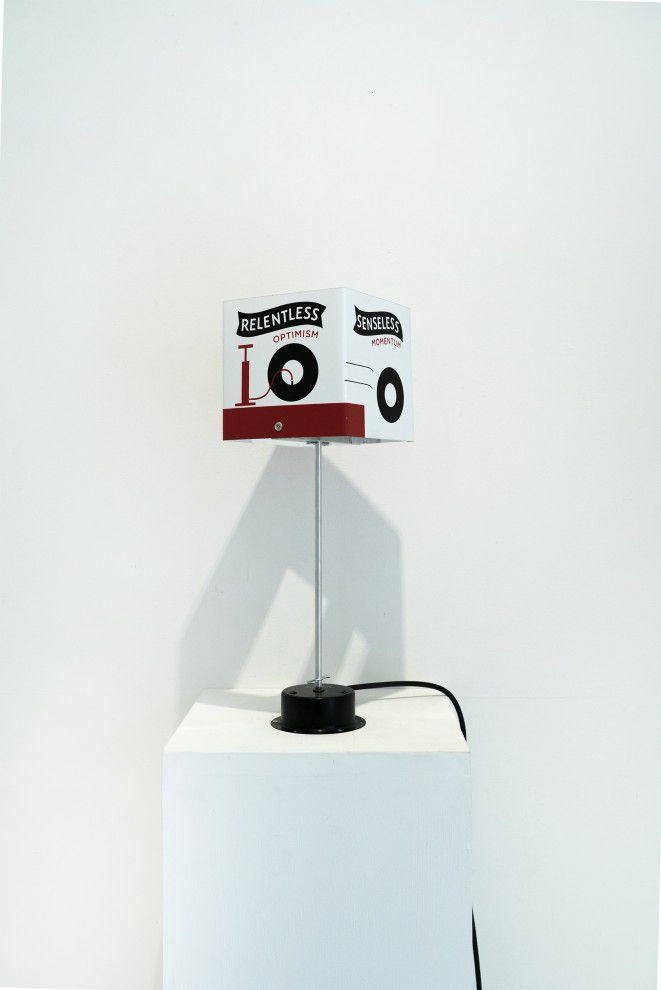
— (ランプ作品を見て)なぜこの素材にペイントしたんですか?
Stephen “ESPO” Powers 「これはアルミだよ。僕はアルミにペイントするのが好きなんだよ、この素材はサインペインティングに最適だ。すごくシンプルで、愛らしくて、生きている感じで、とてもモダンなんだ。さらにはハンドメイドで作っている感じも出したかった。自分で作ったんだけど、すべてがこの一つに集約されている。シルクスクリーンに関しては、ブルックリンにあるショップ(ESPO’s Art World)の地下でプリントしている。僕たちはハンドメイドでシンプルなものを作りたいと思っているんだ」
–What material is this? And why did you choose this material?
Stephen: “It’s a aluminum. Because I love paint on aluminum. Sign painting, it’s really simple material, it’s adorable, it’s life and it’s very modern, when you make some that’s really clean. But we wanted to make something that looked hand-made. So everything here, we made this ourselves. We screen printed it in the basement of my shop, (the business card I gave you). We wanted to make something that was hand-made and simple. These beautiful toys that are from Broadway, Nagano, they’re beautiful wooden toys that are hand-made, hand-painted, and really elegant. They’re old fashioned and they’re kind of boring but they’re beautiful. It’s not like a finished, polished, object. It’s not like a toy or a really well made product. I want to show the effort. Everything here you can see effort. You can see work in all of it. Nothing looks effortless. It all looks like hard work.”
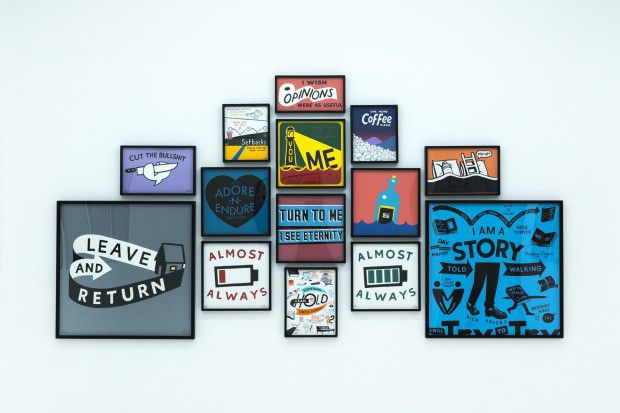
— 屋外で描くときは、たいていこの素材で描いていると聞きましたがそうなんですか?
Stephen “ESPO” Powers 「サイン・ペインターが使っているものだからね。今、日本には数名のハンドメイドのサイン・ペイティンターがいると思うけど、すごく減ったよ。ヨーロッパでもほぼいなくなってしまった。アートは実用性を持たなくてもいいものだから、サイン・ペインターたちがこの素材を使わなくなったとき、アートで使うべきだと考えたんだ。実際に使ってみるとすごく良い感じなんだよ。でもこの素材を使ってサイン・ペイントを始めたくらいから、どんどんサインペインターを見かけなくなってしまった。ビジネスが枯れ果て、彼らはリタイアして別の仕事をしていたんだ。長い月日をかけてサイン・ペインターに会って、うまくなるためにかなりの時間をともに費やした。サイン・ペインターは仕事が早い。僕は彼らのように早く描けるようになるために、毎日描いているんだ。早く描けるようになったら、考えることも止めて、オートマティックにもっと描けるようになるからね」
–I heard you started this in 2011.
Stephen: “I wanted it to be like a diary. I wanted to paint something every day so for most of the days in the year I made paintings every day. It was me figuring out how I could paint fast and I wanted to make a little painting every day. A masterpiece hopefully. But even if it was a good day or a bad day, it didn’t matter as long as I got something done.”
–I heard you always write down the material, when you work outside?
Stephen: “Yes, it’s what sign painters use. There are very few hand painted signs in Tokyo right now. I saw few. When I see them, I jump back. And in Europe too, they’re disappearing. Art shouldn’t have utility. So as soon as the sign painters stopped using the material, it seemed like a good time to use it as art. That’s why I used it. I was like okay, I’m not competing with the sign painters. When I first started painting signs and using material, I couldn’t find any sign painters. They were all retired and their businesses dried up and they were doing other things. So for three or four years it was me and one other person and we taught ourselves. And then, we started meeting people, we started meeting artists and we started meeting sign painters. It took a long time. It was amazing how long it took to get good at it. There’s so much effort in these, it’s too much effort. Sign painters work so fast, and they don’t care, and they’re too tired and they’re too busy and they’re broke and they want to finish the job, they want to get paid. That’s why I painted every day, because I wanted to learn how to paint fast. I wanted to get to the point where I just painted, and I just didn’t care anymore. I’m just fast, and it’s good enough. The faster you paint, the more you paint. You stop thinking and it’s just automatic.”
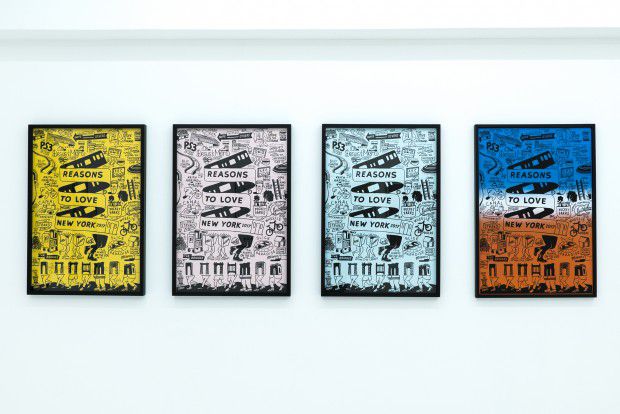
— ステファンが描くサイン・ペインティングは、ストリートからの目線もあり、両方の要素を兼ね備えている感じがします。
Stephen “ESPO” Powers 「グラフィティを辞めてサインペイン・ティンターになってからは、自分の内なるメッセージを伝えていたんだ。グラフィティ・ライターの外のコミュニティからね。だから初めてコニーアイランドで仕事としてサインペインティングを描いたときは、自分のサインを入れなかった。だけどグラフィティ・ライターの友達が『君がやったことは知ってるよ。だって君のレタリングで、アプローチで、君そのものだったからね』と言ってきた。『最高だ!』と思ったね。だってもう犯罪に関与することもなく、みんなから怒られることもなく描くことができるんだとね。グラフィティを描いていたときは、ESPOというワードに恐れを感じていたんだ。ようやくアーティストになって、今はすべての名前を使って仕事ができるようになったんだ」
— So there are so many different meanings in your sign painting and your diary. But it’s interesting to me because you were on the street right? So you’re always watching what’s going on in the city? If there’s someone working on the inside, they don’t know?
Stephen: “What was interesting was, when I stopped writing graffiti, I started with the sign painters. What I did was, as a graffiti writer I was on the outside of the community, broadcasting, sending my message to the inside, to the center. When I became a sign painter, I went to the center of the community and I broadcasted to the outside, where I used to be. So the first placed I worked was in Cony Island and I painted sign paintings on the island, and I didn’t sign anything, but the graffiti writers said, “I knew you did that. I recognized your lettering, your approach, I knew that was you.” I said, “This is great!” I don’t have to commit crime, I don’t have to make anybody mad at me, I just paint signs. When I wrote graffiti, I worried about one word: ESPO. When I became an artist, now I work with all of the other words.”
— シルクスクリーンは自分たちの手で刷っているんですか?
Stephen “ESPO” Powers 「ここにあるプリントのほとんどを自分たちでやった。僕は以前、雑誌を発行していたんだけど、印刷に関してはいろいろ経験したんだ。サインペインティングに夢中になったけど、印刷にも興味を持っていた。今は両方学ぶことができて、1色で印刷していた頃よりもステップアップできたんじゃないかな。(作品を見て)これだけは、ルーサー・デイヴスというブルックリンにいる印刷マスターが手がけたんだ。彼が印刷するとモダンになるんだよ」
Stephen: We printed most of the works here ourselves. It was really interesting to learn everything about sign painting. And then printing, just was around the corner. Maybe we should’ve done printing first. It would make sense. I used to publish a magazine, so I had some experience with printing. Back in the days we actually printed magazines. I got into sign painting but printing I was always really interested in. We’re now learning printing the way we learned sign painting, just one step at a time, one color at a time. This is a master printer. There’s 14, and there’s this fade in the background. And I was upset with this so we reprinted it, and this version is better. I love it. Luther Davis is a master printer in Brooklyn, amazing. He’s a little more modern. He’s using pretty modern techniques. This one, these two are lithographs from Copenhagen, and you can see this on my Instagram if you go back a little bit you’ll see how we made these. I painted on stone and then… they paint it and they press it on paper until it falls apart. It’s beautiful. I brushed this all out, very fast, ink on the stone. The painting is brush, ink and brush. You know, just as fast as I can. This too. This I painted, I brushed out, when we screen printed this in our basement. But you can see and the brush, just acrylic, just as fast as I can. And if you look at this compared to the work downstairs, this is really fast and confident and it’s not fussy at all, it’s just fast. I’m tired, I’m very good but I’m angry and I wanna go home. This is me trying to finish my work and go home, haha. I could paint this probably in an hour. Just to prep and think about it. I can probably do it in half an hour, if you really pushed me. If I’m really hungry I can finish in 30 minutes. But the idea of sign painting is, you get something done before lunch, and you get something done after lunch and before you go home. You get one thing done in the morning – if you can, two things, and you try to get one or two things done in the afternoon. That’s a deck. So you paint a sign in the morning, you paint a sign in the afternoon. Good ideas in the morning, you probably do your emails, and your admin, you have good ideas… All I know is myself.
— たくさんキャラクターが集まったような作品が可愛いです。
Stephen “ESPO” Powers 「2001年に結婚してハネムーンみたいな感じで日本へ初めて来たのが2002年。そのときはタイトルなしでショーをやったんだけど、来日して初めてDocomoの携帯で絵文字というものを見たんだよ。その年に、僕はその絵文字をもとにこの作品を発表した。アメリカではキーボードのトリックをつかって顔文字を作っていたけど、『日本が生み出したこの絵文字は、いずれ世界を制覇する!』と思って、僕はアーティストとして、その絵文字をただのスマイリーフェイスだけで終わらせたくなかったんだ」
Stephen:When I first came to Japan, it was 2002. It was for the Untitled Show. We had just gotten married, it was January of 2001. And the first thing that I saw were cellphones. And I saw Emojis. The first Docomo. They invented Emojis in 1999. So I saw them 2001. And by 2002, I was drawing like this. And what I remembered I was like, “Japan did it, and I know this is gonna take over the world.” America, we were just using emoticons, keyboard tricks. But I knew someday everybody was going to have Emojis. So as an artist, I said it can’t be just the smiley face. It has to be a word, and a picture. A little more complicated, a little stranger, a little more. But that’s where it came from.”
–How many years have you been printing with Luther David?
Stephen: “Luther has been printing for 30 years. We printed with him for about five years, and we said, we should learn ourselves. And he said, “okay, get this one printer, get this one machine.” He said, “I’ll see you in 20 years.” He’s in Brooklyn. We did all these. He did this one. We’re on our own now. This is Luther. The rest of them are ours. That’s why he’s by himself, because he’s the master printer. Show him some respect, give him his own space.”
— 今はニューヨークのどこに住んでいるんですか?
Stephen “ESPO” Powers 「マンハッタンのウエストヴィレッジに住んでいるよ。『Sex and The City』でお馴染みのサラ・ジェシカ・パーカーの家の右隣にね。ショップとスタジオはブルックリンで、ボーラムヒル地区の4th AvenueとBergen Streetにある。すごくクールなエリアだよ」
–Now you live in Brooklyn?
Stephen: “I live in Manhattan, I live in West Village. Right by Sarah Jessica Parker’s house. Right by Sarah’s house in Sex and The City. My Studio is in Brooklyn, it’s on 4th Avenue and Bergen Street in Boerum Hill.”
— なぜスタジオをブルックリンに選んだのですか?
Stephen “ESPO” Powers 「向こうが選んだんだよ(笑)。アーティストだった家主がいて、彼は先生でもあり、ものすごく素晴らしいアーティストだったんだけど、彼の息子が仕事を探していて、僕たちはスペースを探していたんだ。そしたら『ここをいい家賃で貸してあげるから、息子を雇ってくれないか』と言ってきたんだよ。その息子は今、僕たちの印刷業務を担当してくれている。すごくいい取引をした(笑)。ショップを1階に設けているんだけど、本当にベストなネイバーを見つけたと感じるよ。もしアートを売りたいとしたら、このエリアは適していないんだ。奇妙なエリアだけど、すごくパワフルで、裕福ではないけど、ものすごく貧乏ではない人々が住んでいる。リアルなニューヨークを感じることができるんだ。そんなエリアの一部で、僕たちはするべきことをやっているんだ」
–Why did you choose this area?
Stephen: “It chose us. We had a landlord who was an artist, he’s a great artist, he’s a teacher. He has a son who needed a job. We needed a space. He said, “You can have the space, I’ll give you good rent. You have to hire my son, give my son a job, put my son to work.” He’s our printer. It was a good deal. He’s running the print and it’s a great deal. And it’s interesting, if we were really trying to find the best neighborhood to sell artwork, this would not be the place. But because it is so…It’s a perfect neighborhood for us. I’m really happy with my neighborhood. It’s so strange, but so powerful. It’ not very wealthy, it’ not very poor, there are poor people, there are wealthy people, everybody is there. It’s a very interesting place. It’s still very real New York. It’s very strange. A little more Brooklyn. We do our part to be there, you know, we do what we can.”
— ショップはどんな感じなんですか?
Stephen “ESPO” Powers 「自分の作品を売っているけど、ギャラリーみたいなものだね。携帯をチャージしたり、道を聞きにきたり、やってきた人たちに対して対応している。僕たちはみんながハングアウトできる場所になればいいなと思っているんだよ。たくさんの人たちがくるけど、でもアートワークを買うほどの金は持っていない。彼らはただ作品を見ていくだけだけど、それが僕らにとっては最高なことなんだ。もっともっと来てもらって、作品を見ていってもらいたい。週末は売れるんだけど、平日は近所のキッズに夢を見させている感じ。僕たちは教育して楽しんでいるんだ」
–You have the second floor. You have the basement, and the first floor?
Stephen: “The shop is in the first floor and we have a basement. It’s a gallery. Yeah, sell my work. It’s a place for people to come, they hang out, they charge their cellphones, they get directions, we try to just be available. We wanna be a place where people come and they hang out. A lot of people they come, and they don’t even have the money for artwork, and they just wanna come and look at it. And that’s great, we wanna be there for them to do that. We get 100 people come in every day, and on a Saturday and Sunday it’s 100 people. During the week, it’s like maybe 20 people. Nobody buys anything. We make a few sales. On the weekends we’re very busy, we sell a lot of work on the weekends. And on the weekdays it’s like, it’s kids, dreaming. It’s young people dreaming, it’s older people that have no idea what they’re looking at. But we educate and we enjoy.”
—どんな人たちがギャラリーにくるんですか?
Stephen “ESPO” Powers 「ティーンネイジャーから、リタイアした人々、海外から旅行でやってくる人といろいろだね。本当はアーティストとしては、ギャラリーをやるといいことはないと思っていたんだ。でもやる機会ができてしまった。友達もいるし、僕たちのやりたいことをやってみようってことで、作品を見せて人々を教育してみることにしたんだ。それが面白くてすごく楽しいけど、すごくストレス(笑)。簡単なことではないけど、とてもポジティヴな場になっていると思う。そして僕自身、アーティストとして人々を待たせてはいけないし、自分の中から生まれてくるものを創り出さないといけない。すべてのアーティストに各々の時間があって、芸術が生み出される。だから僕たちが何をするのかって、ただアートを創るしかないんだよね」
— What kind of people come to the gallery?
Stephen: “Everybody, It’s like teenagers, to retired people. And people travel from all over. It’s really interesting. As an artist, I didn’t want to have a gallery. I wasn’t thinking like that was a good move to make. But the opportunity presented itself. I had friends and we wanted to work and we wanted to figure it out so that’s what we did. So I show my own work and I educate people, and it’s really interesting, it’s really fun and stressful. It’s not easy, but it’s a really positive place to be. And as an artist in the work., you can’t just wait for people to give you shows. You have to make your own things happen. You have to make your own shows happen, for most artists. Some artists, it’s all happening, it’s their time. For every artist they have their time, but art is made in the meantime, in the downtime. So that’s what we do, we just make art.”
— 30年くらいアーティストとして活動していることになりますか?
Stephen “ESPO” Powers 「18歳くらいの頃からだから32年くらいだね。1984年から今に至るけど、僕にとってアートは人生そのものなんだ。今月で50歳になるんだけど、絵は3歳から描いているんだ。車の絵を描いていたことを覚えている。それが僕の絵を描くことの物語の始まりかもしれない」
–So 30 years have passed since you started art?
Stephen: “Yeah, but for me it’s my whole life. Okay, but let’s say from 1984 until now, yeah. But for me from 1999 or 2000 until now. So it’s either 18 years or it’s 32 years or it’s 50 years. I’ll be 50 in a month. For me the story starts from when I was 3 years old. I could remember drawing a car. So that’s when the story starts for me. Drawing little things. When I sleep I sleep, we’ll see. I love sleeping. Sleeping is fun.
Now it’s canvas. Now I’m moving for canvas. Just this year I started painting on canvas. Very different. It’s very different it’s very strange, it’s really interesting, it’s been a very slow process but it feels really natural and it feels really good. It slows me down a lot. It feels right. It feels natural, it feels correct. Real acrylic on canvas.”
— これからはどんな作品に挑戦してみたいですか?
Stephen “ESPO” Powers 「今、キャンバスに描いているんだけど、心を奪われているよ。始めてちょうど1年経つけど、これまでやってきたことと違うし、とても奇妙。でもすごく楽しいんだ。描くのもゆっくりだし、プロセスがとても自然な感じで心地よいんだよね。この感じは、間違っていないと思う」
— 日本のファンへメッセージをください。
Stephen “ESPO” Powers 「アイラヴユー。僕は日本にいるとデカイし、不器用だし、恥ずかしいんだけど、日本は僕をリラックスさせてくれて、エレガントな気分にさせてくれるんだ。素晴らしいギフトをもらったような気分になるんだよ。毎回、日本へくるといい気分になる。ありがとう!」
–Please give a message to the Japanese people.
“I love you. I feel big and clumsy and embarrassed in Japan. Japan makes me want to be slower, more elegant, more careful. It’s a very precious gift I get. Every time I come here I want to be better. So thank you. Arigato!”
photography Naoto Sakamoto
text Kana Yoshioka
edit Ryoko Kuwahara
“There Are No Wrong Answers”
by Stephen Powers
April 5th (thur) – 24th (tue), 2018
Open 12-7 pm (except on sun. & holidays)
GALLERY TARGET
2-32-10 Jingumae, Shibuya-ku, Tokyo 1500001
+81 3 3402 4575
www.gallery-target.com
Stephen “ESPO” Powers
1968年生まれ。ニューヨーク在住。1984年16最の頃からグラフィティ・ライターとしてESPOという名前で描き始める。1994年ニューヨークに移り「Go Magazine」を発行、1999年にはライターを辞めアーティストとして活動。以後、ベネチア・ビエンナーレやリバープール・ビエンナーレに参加、世界中のギャラリーや美術館にて作品を精力的に発表中。アーティストとしてパワーズは屋外でも様々な活動を展開。「LOVE LETTER TO THE CITY」はパワーズがアートで街にラブレターを書くプロジェクト。2005年にコニー・アウランド(ニューヨーク)市長とともに、コニー・アイランド復興のため遊園地にあるサインや乗り物をポワーズがキュレーションしたアーティストたちと共にペイント。2007年、フルブライト奨学金をもらいダブリンの街にミューラルをペイント。街や自治体を協力し、ポルティモアのミューラル・アーツ・プログラムより依頼されフィラデルフィアの街に50以上のミューラルを制作。活動は東京を含め、サンパウロから南アフリカ、世界12都市に及ぶ。2015年にニューヨーク市のサマー・ストリート・プログラムより依頼され電信柱にパワーズが描いたサインを設置。ポジティブなメッセージやアートを必要とする地域にラブレターを描き続ける傍ら、拠点のニューヨークでは自身のサインショップ”ESPO’s Art World”を経営している。
主な展覧会:ダイチ・プロジェクツ(ニューヨーク)、アリス・ギャラリー(ブリュッセル)、ギャラリー・ターゲット(東京)ペンシルベニア・アカデミー・オブ・ファインアーツ(ペンシルベニア)、シンシナティ現代美術センター(シンシナティ)、ロサンゼルス現代美術館(ロサンゼルス)、ブルックリン現代美術館(ブルックリン)
